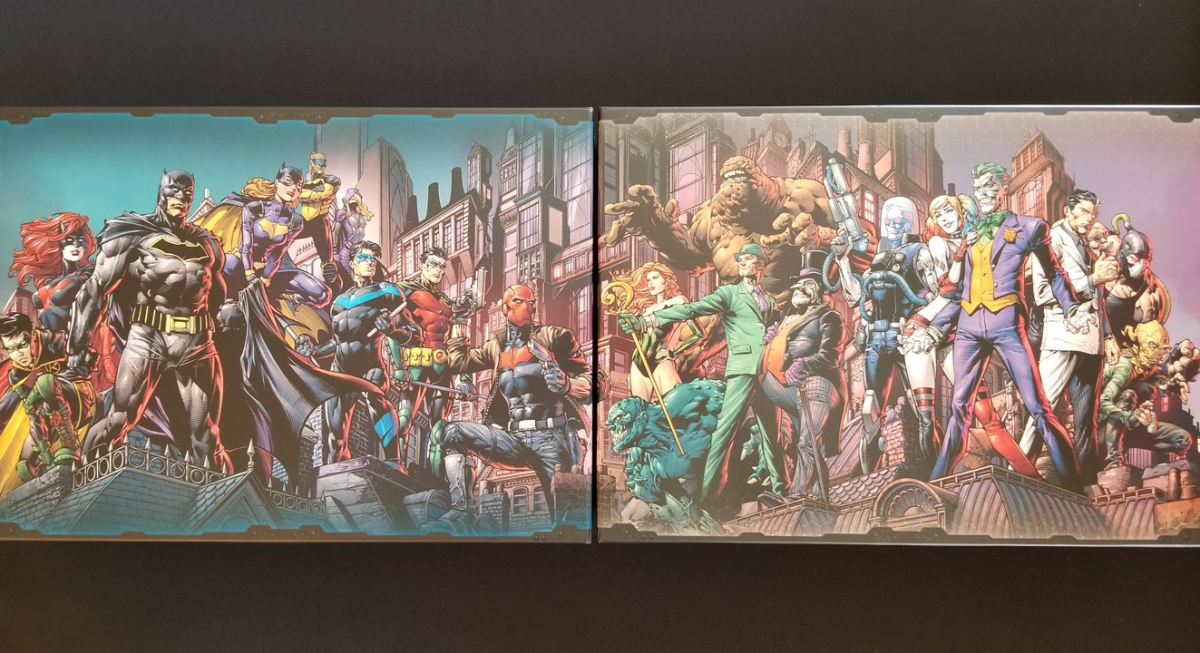Batman: Gotham City Chronicles is big, beautiful, complex, heavy and, most importantly, a ton of fun. This isn't the game you are going to reach for when you want to take a quick detour into a fantastical world, roll some dice, have a few laughs, and then call it a night. Instead, this is the game that you reach for when you want to have a tense, think-y, tactical experience full of planning and strategy. This isn't the POW, ZOT, THWACK! slapstic Batman; rather, this is the study, plan, investigate and execute Batman. This game is mechanically dense, yet manages to weave those mechanics into the theme wonderfully, and while it doesn't execute on every level flawlessly, it still works really well and is incredibly fun.
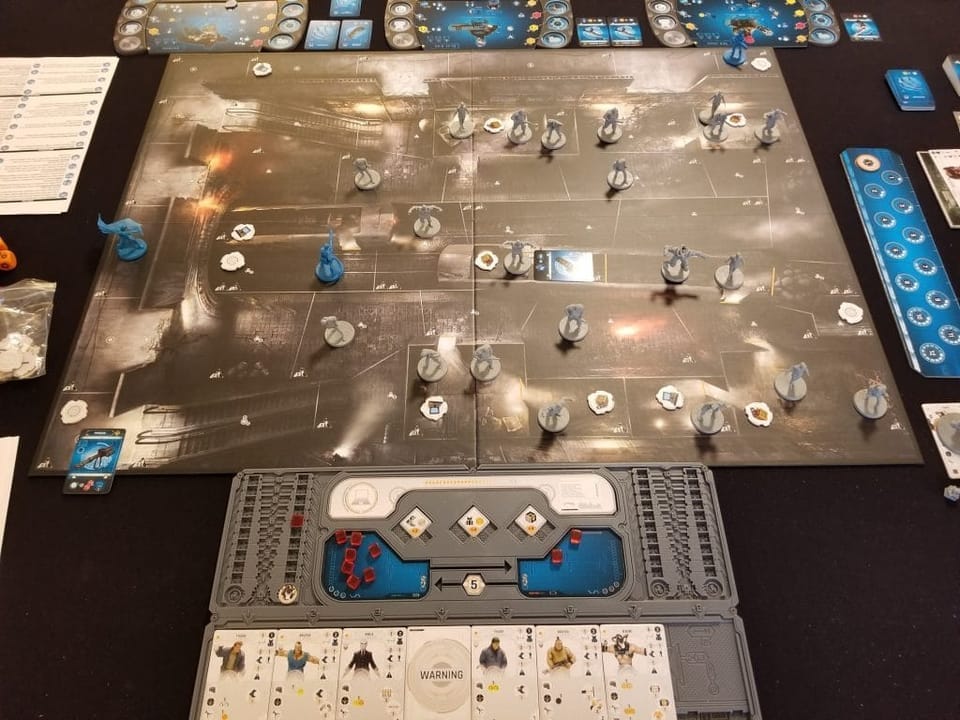
Batman: Gotham City Chronicles is a 1 vs many game, so go into it knowing that one player is going to be in control of the various Bat-villains and their goons and underlings (nearly) every time you play. From Bane, The Joker, The Riddler, and The Penguin through Orphan, Manbat, and crooked cops there is a veritable rogues's gallery of baddies and thugs to play, and the cast is just as varied and diverse on the Bat-side of the law. Four different versions of Batman, multiple Robins, Batwoman, Batgirl, Nightwing, Commissioner Gordon and Azrael team up with the likes of Lt. Montoya and even the ridiculous Batcow to fight all manner of crime in Gotham City. If you are a fan of Batman there are characters here that are both bound to appeal to your preferences and confuse you slightly unless you are a rabid fan.
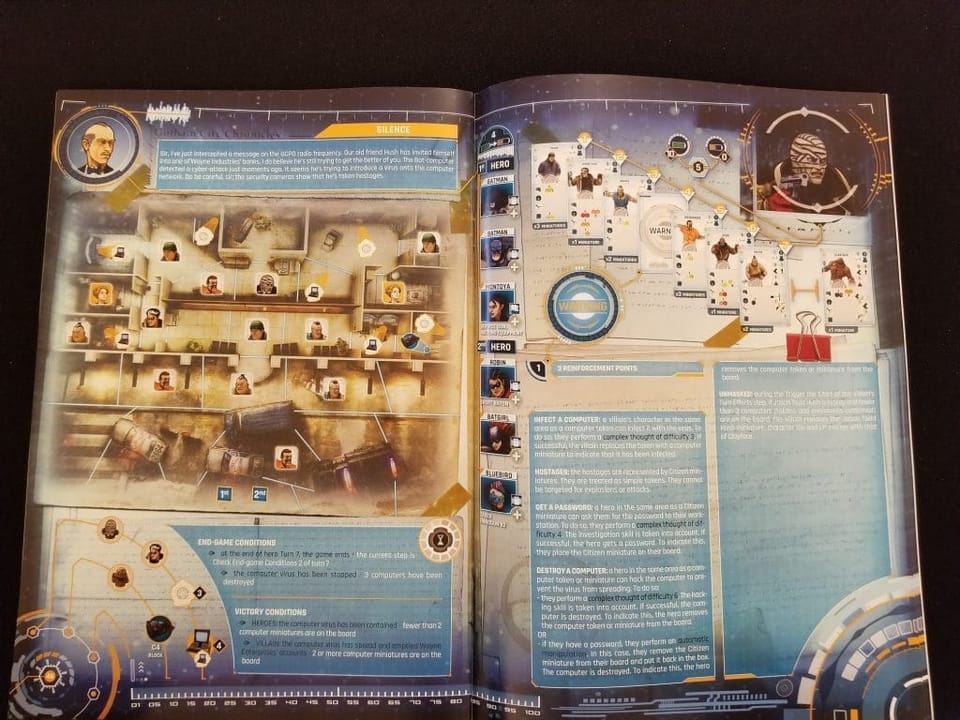
The mission structure in Gotham City Chronicles is nearly as varied as the characters. There are over 2 dozen missions, each with unique goals, and nearly all of which offer the hero characters a choice of which heroes to bring to bear against that missions villain(s). Those missions, and the goals set forth therein, are the real heart of this game. Sure you'll be slugging it out and using Bat-gadgets to incapacitate the goons and villains, but each mission lays out a set of goals, and a time limit to accomplish them in. If you are too focused on fighting, and don't push to complete those objectives then you are going to lose. Period. One of the most brilliant thing about the missions is that they vary in both goal and structure. Many missions task the heroes with completing one or more objectives, while the villains try to stop them, but sometimes the roles are reversed, with the villains trying to accomplish an objective while the heroes try to stop them. One of my favorite missions is that type, and puts the heroes in the shoes of Lt. Montoya, Harvey Bullock, and Commissioner Gordon with nary a 'super' hero in sight to help stop the baddies.
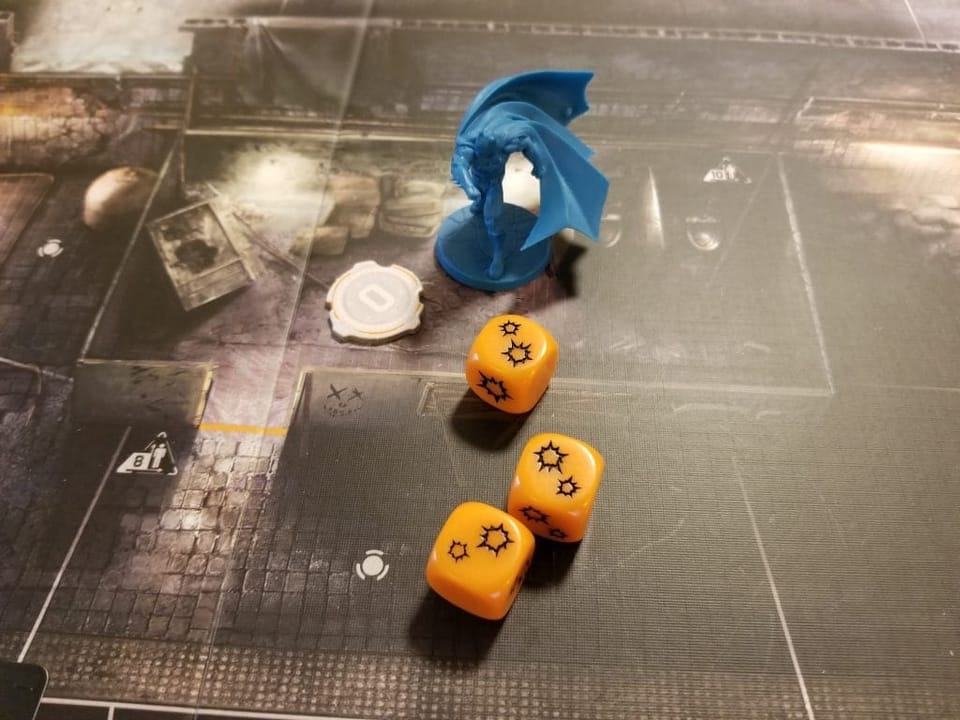
The goal-oriented mission structure not only prevents the game from becoming a simple slugfest, but it actively rewards players for planning ahead, strategizing, and thinking and acting tactically. The hero characters need to pay attention to who they choose to use, how to equip those chosen characters, and how they plan to tackle the objectives laid out before them, all while the villain player figures out how to use the resources at their disposal. When you play the villain it isn't simply enough to try to damage the heroes, as many missions lay out various traps and tricks that the villain player can use to try to thwart the heroes, and character positioning can be just as important as a damaging attack. Even though the villains used pre-determined setups for each mission, the tactics and strategy employed are just as important for the villain player as they are for the heroes.
[gallery size="medium" ids="296398,296399,296400"]
The choice of hero characters can be difficult because the heroes skill-sets and stats can vary wildly from one to the next. The number of skills in Gotham City Chronicles is massive, and can have a profound effect on how you use a hero and how you approach a mission. One version of Batman might be better at disarming bombs than another, who is a better melee brawler, but which do you choose when you are tackling a mission that requires you to hack computers? The choices of which heroes will best suit a mission are rarely straightforward, so the hero player(s) have to figure out the best way to use all of the characters at their disposal as a team, to both cover each others weaknesses and play to each others strengths.
[gallery columns="2" size="medium" ids="296401,296402"]
The cast of villain characters varies wildly as well, with the added conundrum of deciding when the right moment to activate a villain or group of thugs might be. While the hero characters activate every turn, with the exception of turns in which they choose to rest to heal and regain energy, the villain uses a dashboard to activate the baddies. The villain cards are situated in a 'river' at the bottom of the dashboard. Cards to the left of the dashboard are cheaper to activate, and then move to the far right after activation, making all other cards' activations cheaper. The villain player can simply activate the cheapest cards, and then hope to bolster them by spending excess energy on armor, extra movement and re-rolls, but paying a big cost to activate the right group or villain at just the right moment can have a profound impact on how the game plays out.
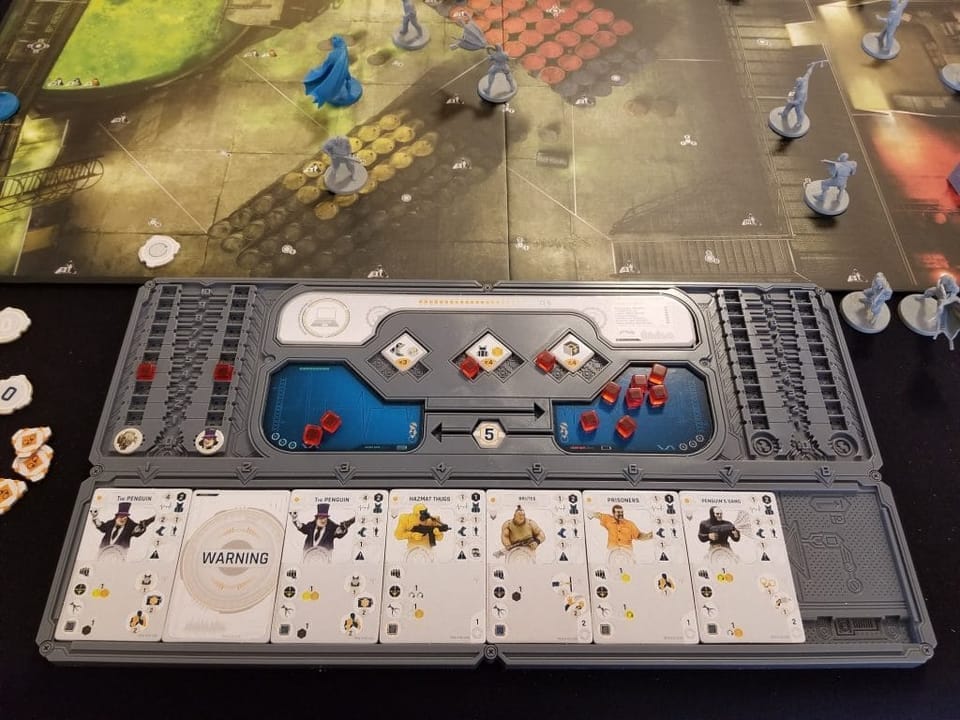
While tactics and strategy are the name of the game here, keep in mind that this is a dice-driven game. Nearly all outcomes of actions taken, from picking a lock to disarming a bomb to shooting Batman in the face are determined with the roll of dice. There are ways to mitigate the luck of the dice to an extent, both the villains and heroes have the option to re-roll dice at the cost of energy, and some equipment cards and skills allow free re-rolls, but the dice still do what dice do best, both disappoint and exhilarate. It's heartbreaking to lose a mission because you came up one success short, and equally exciting to win on the final possible roll, but if you are dice-averse then know that no matter how well you plan the dice can still be your ultimate downfall.
[gallery columns="2" size="medium" ids="296404,296405"]
I've mentioned energy a few times so let's dive in to that now. Energy cubes are the life blood of both the heroes and the villain. Both sides have a pool of cubes that are used to activate their characters, and only a few cubes are regenerated each round. The villain gets a set allocation while the heroes get either a few if they take a Ready stance, or a handful if they Rest. Every action that the heroes take requires one or more energy, and dice are usually allocated on a 1:1 ratio with the amount of energy spent on the action. Excess cubes can be used to re-roll, or they can be saved to help bolster defenses. This means that it's always a balancing act, especially for the heroes, of spending your resources to accomplish your goals without overextending yourself. To top it off, the energy cubes also double as the character health pool, and wounds taken directly decrease the amount of energy that you can have in reserve. If you ever take too much damage then you have no choice but to rest, so it behooves the villain player to try to deplete the heroes' energy via wounds while also not overextending themselves, while at the same time the heroes have goals and objectives that they must accomplish on a fixed timeline, but pushing too hard will leave them vulnerable.
[gallery size="medium" ids="296406,296407,296408"]
It takes experience with the game to know when to hold back and when to really exert your heroes, and the right decision can mean the difference between disarming the last bomb just before it detonates, and having it blow up in your face and crush you under a pile of rubble. It's an excellent system, and it really makes you consider your tactics and choices. When you find the right balance, it feels like a ballet of efficiency and tactics, but when you get it wrong it can be absolutely brutal as your opponent punishes you for your mistakes, and since both players have to walk the line, albeit in different ways, it really usually like the outcome of the mission was determined by who made the better plays, unless one player had an exceptional run of bad luck with the dice. While the dice can turn on you, usually the choices that you make really make the difference, because if you left yourself no other option than to roll-and-pray it was ultimately your choice to do so.
A note on player count: The missions in Batman: Gotham City Chronicles all require 1 Villain player and 1 to 3 hero players. While most missions require 3 heroes, and thus can accommodate 4 players, we found that regardless of the number of heroes the game plays best with just 2 players. The game is still fun when played with more players, but it's a tighter, more focused experience when playing with just 2, even if that means the hero player is controlling multiple characters at once.
A note on “chrome”: Batman: Gotham City Chronicles has some of the best components I've seen to date. The miniatures are second to none, the cards and cardboard components are well made, and the art is straight out of the comic books. There are a few places in the rules and the mission book where the verbiage isn't consistent (one mission calls objectives Toy Boxes and Boxes of Dolls interchangeably) and a few places the original French words didn't get translated into English, but it's not egregious enough to cause a problem while learning or playing the game. The game would benefit from a few reference sheets, especially for the skills and the terrain layouts for the boards, because currently your only option is to flip to the back of the rulebook to check skills and the back of the mission book to see elevations etc. It gets easier over time to play without referencing those two things, but it takes quite a few games simply because of the sheer volume of skills. The variance in skills are one of the best things about the game, but it can be a drag to have to constantly flip through the rules to reference them.
The bottom line:
Batman: Gotham City Chronicles is a beast of a game. Not only is it such a big game that it comes in two boxes, but the rules are dense, the cast of characters is vast, and the sheer number of skills and abilities for those characters borders on the ludicrous. For all of that it's also a mechanically tight game with excellent pacing, fun missions and quick, brutal combat. Designed for 2-4 players, the game actually plays best with 2, not simply because there are missions that use only a single hero character, but because the balance is so tight that a single slip-up by the heroes can often mean the difference between victory and failure, not to mention that it has the added benefit of keeping downtime to a minimum. The heroes are easy to control and intuitive enough that controlling 3 heroes at a time is easy to do, so grab the biggest Batman fan you know and a copy of this game and settle in for dozens of missions of crime-fighting (or crime-committing depending on the side you choose) fun.
Get this game if:
You love Batman and want to feel like you are playing out scenes from the comic books.
You like scenario and goal driven gameplay.
You like 1 vs many games.
You like games that are both tactically and mechanically complex.
You collect miniatures and want some of the absolute best (if not the best) Batman minis on the market.
Avoid this game if:
You want a skirmish game where combat is more important than scenario goals.
You dislike dice-driven combat.
You prefer games with a lower level of complexity.
The copy of Batman: Gotham City Chronicles used for this review was provided by Monolith.
Where's the score? The TechRaptor tabletop team has decided that the content of our tabletop reviews is more important than an arbitrary numbered score. We feel that our critique and explanation thereof is more important than a static score, and all relevant information relating to a game, and whether it is worth your gaming dollar, is included in the body of our reviews.
Review Summary
Have a tip, or want to point out something we missed? Leave a Comment or e-mail us at tips@techraptor.net
